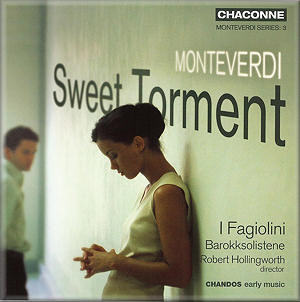 |
 |
|


alternatively
CD: AmazonUK
AmazonUS
Download: Classicsonline
|
Claudio MONTEVERDI
(1567 - 1643)
Sweet Torment
Il quinto libro de madrigali (1605)
1. Questi vaghi concenti [7:06]
2. T’amo, mia vita! {2:53]
Il sesto libro de madrigali (1614)
3. Ohimè il bel viso [4:51]
4. Zefiro torna, e’l bel tempo rimena [3:29]
Scherzi musicali cioè arie, & madrigali in stil recitativo
… (1632)
5. Zefiro torna, e di soavi accenti [6:13]
Concerto. Settimo libro de madrigali [1619)
6. Ohimè, dov’è il mio ben? [4:44]
Quattro scherze delle ariose vaghezze … (1624)
7. Si dolce è’l tormento [4:27]
Madrigali guerrieri, et amorosi … Libro ottavo (1638)
8. Or che ‘l ciel w la Guerra [7:25]
9. Gira il nemico insidioso [5:42]
10. Ballo delle Ingrate [32:04]
 I
Fagiolini; Barokksolistene/Robert Hollingworth I
Fagiolini; Barokksolistene/Robert Hollingworth
rec. Church of St Michael and All Angels, Summertown, Oxford, 27 -
29 January 2009
Texts and English translations enclosed
 CHANDOS CHACONNE CHAN 0760 [79:02]
CHANDOS CHACONNE CHAN 0760 [79:02]  |
|
|
I Fagiolini, which according to my dictionary means ‘The
Beans’, were founded as long ago as 1986 and have been
giving concerts around the world ever since. This is their tenth
CD for Chandos and I deeply regret that I hadn’t heard
them before. According to the booklet notes ‘its name has
become synonymous with innovative staged productions of Renaissance
music-theatre works’. This was also the very first impression
when I started playing the disc. This is not only highly accomplished
singing, but also - and indeed even more - lively interpretations
with more than a whiff of the stage. In fact it is the emotions
and the drama that are the foundations for the music that protrude
with graphic precision and makes music that can give the
impression of staleness to ears accustomed to more overtly dramatic
music from the last three centuries.
The singing is excellent, no doubt about that, but I conclude that the very last ounce of polish is sacrificed for the sake of communication - and I greatly prefer that to the kind of academic correctness that easily becomes bloodless. In ensembles the sound can sometimes be a little raw and rough at the edges and I have heard groups with smoother homogeneity. But this is a more or less negligible drawback against so much excellent and engaging vivacity and insight.
Individually tenor Nicholas Mulroy stands out as a dramatic and expressive soloist in Si
dolce è ‘l tormento (tr. 7), the piece that lends its name to the whole collection. But there are splendid contributions from other singers as well, most notably in the concluding Ballo delle Ingrate (tr. 10), where Clare Wilkinson is an engaging Venere) and the sepulchral Jonathan Sells a strongly dramatic Plutone.
The programme is presented largely in chronological order, as far as years of publication are concerned. The exceptions are the two Zefiro torna madrigals
(tr. 4 & 5), which certainly are settings of different texts, the first by Petrarch (1614) the other by Rinuccini (1632) but they are within the same motif. The latter is actually a parody of Petrarch’s.
Generally it could be stated that the older Monteverdi got, the
braver and more modern he became. The early madrigals are more
or less in the recitative style of his early operas, which were
more or less contemporaneous. When we reach the late 1620s and
1630s we are in the multifaceted world of his late operas, and
the irregularity, sharp contrasts and dramatic outbursts of Si
dolce è ‘l tormento is typical. Gira il nemico insidioso (tr. 9) - lively, virtuoso and sometimes chaotic - is even more modernist. Ballo delle Ingrate was published in 1638 but differs greatly - not only in length but also in style. It was also written in 1608, along with Arianna,
of which only the celebrated lament has survived, to celebrate
a wedding. What is known is that there were textual changes made
for the publication. Whether the music was also modified nobody
knows, though some scholars feel that there are certain things
that point to the 1620s. However, the original text was published
in 1608, and this is the text that was used for this recording.
At least in Plutone’s monologues there is true operatic drama and the work opens spectacularly with urgent timpani rolls. Monteverdi, though he wasn’t
the creator of opera, was the first to really realize the potential
of music-drama.
Barokksolistene, on period instruments, contribute excellently, as do the continuo instrumentalists. The recording is excellent and there are highly interesting and informative notes in the booklet. All in all, then, a highly accomplished and engaging disc that should be a revelation - also for those not normally attuned to music from this period.
Göran Forsling
|
|
|

